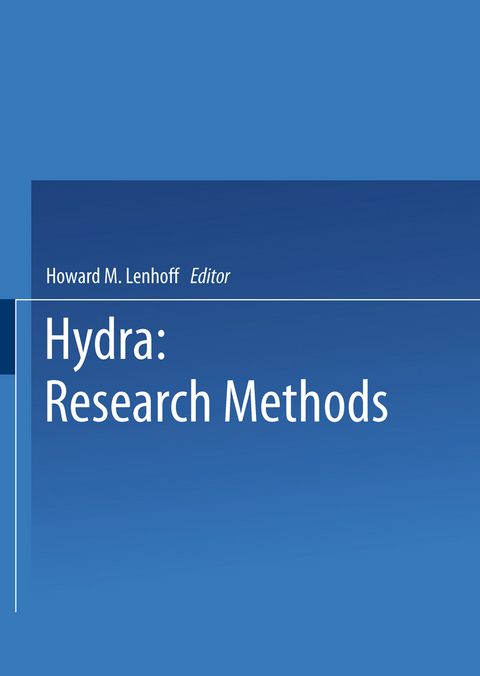
Hydra: Research Methods
Springer-Verlag New York Inc.
978-1-4757-0598-0 (ISBN)
Terminology for Morphology and Cell Types.- Terminology for Morphology and Cell Types.- Culture and Handling.- Collecting Hydra.- Identifying Hydra Species.- Water, Culture Solutions, and Buffers.- Visual Monitoring of pH in Solutions with Phenol Red.- Hatching Brine Shrimp Larvae Axenically and/or in a Range of Quantities.- Determining Growth Rates of Groups of Hydra and Budding Rates of Individual Hydra.- Culturing Large Numbers of Hydra.- Turbidimetric and Pipetimetric Measurements of Number of Hydra.- Culturing Hydra of the Same Species but of Different Sizes.- Culture of Sexually Differentiated Hydra.- Preparing Axenic Hydra.- Histology.- Preparing Hydra for Transmission Electron Microscopy.- Preparing Hydra for Scanning Electron Microscopy.- Preparing Hydra for Freeze-Fracture and Freeze-Etching.- Whole Mounts for Light Microscopy.- Preparing Histological Sections for Light Microscopy.- Vital Staining: Fluorescent and Immunofluorescent, and Review of Nonfluorescent Dyes.- Macrophotography.- Macrophotography.- Quantitative Cytology.- Dissociating Hydra Tissue into Single Cells by the Maceration Technique.- Cell Cycle Analysis of Hydra Cells.- Mitotic Index.- Measurement of the Numbers of Nematoblasts, Nematocytes, and Nematocysts.- Marking Epithelial Cells in Living Hydra with India Ink.- Techniques Using Isotopes.- Incorporating [3H]Thymidine into Hydra by Microinjection.- Labeling with Gaseous 14CO2 or by Feeding on Radioactive Tissues.- Fractionating Small Amounts of Radioactive Tissue.- Rapid Whole-Mount Radioautography.- Isolating Hydra Mutants by Sexual Inbreeding.- Isolating Hydra Mutants by Sexual Inbreeding.- Manipulating Tissue Organization.- Grafting: A Rapid Method for Transplanting Tissue.- Quantitative Interpretation of Transplantation Phenomena.- Dissociating Tissues into Cells and the Development of Hydra from Aggregated Cells.- Culturing Interstitial Stem Cells in Hydra Aggregates.- Separating Viable Tissue Layers.- Preparing Ectoderm/Endoderm Chimeras.- Manipulating Cellular Composition in Vivo.- Eliminating All Nonepithelial Cells Using Colchicine.- Culturing Epithelial Hydra.- Reducing Populations of Interstitial Cells and Nematoblasts with Hydroxyurea.- Preparing Hydra viridis with Nerve Cells and No Interstitial Cells, or with Neither of These Cell Types.- Eliminating Interstitial Cells with Nitrogen Mustard.- Altering Cell Population Levels by Gamma Irradiation.- Reducing Number of Nematocytes in the Tentacles.- Assay and Isolation of Substances Controlling Morphogenesis in Hydra.- Assay and Isolation of Substances Controlling Morphogenesis in Hydra.- Isolation and/or Properties of Acellular Mesoglea and Nematocysts.- Isolating Mesolamellae.- Isolating Undischarged and Discharged Nematocysts from Acontiate Sea Anemones.- Dissolving the Nematocyst Capsule Wall and Identifying its Protein Component(s).- Purifying an Inhibitor of Succinoxidase Activity from Hydra littoralis.- Assays for Activities of Nematocyst Venoms and Their Components.- Analytical Procedures.- Special Techniques for Weighing Microgram Quantities of Tissue and Assaying Them for Enzyme Activities.- Extracting and Characterizing Hydra RNA: Modifications to Allow Extraction of Undegraded Material in the Presence of High Levels of Degradative Enzymes.- Colorimetric Analysis for Protein of Hydra.- Determining Respiration and Oxygen Evolution of Green Hydra with the Rank Brothers Oxygen Electrode.- Symbiotic Relationships.- Isolating Endosymbiotic Algae from Hydra viridis.- Preparing Aposymbiotic Hydra.- Introducing Symbiotic Algae into Aposymbiotic Hydra.- Measuring Number of Algal Symbionts in Hydra viridis.- Measuring in Vivo Translocation of Reduced Organic Carbon Compounds from Endosymbiotic Algae to Hydra.- Spectrophotometric Assay for Maltose.- Methods for Epizootilogical Research with Hydras.- Experimental Methods for Epizootilogical Research with Hydras.- Electrophysiology and Behavior.- Recording Electrical Activity.- Bioassay for, and Characterization of, Activators and Inhibitors of the Feeding Response.
| Zusatzinfo | 134 Illustrations, black and white; XXXI, 463 p. 134 illus. |
|---|---|
| Verlagsort | New York, NY |
| Sprache | englisch |
| Maße | 210 x 297 mm |
| Themenwelt | Medizin / Pharmazie ► Medizinische Fachgebiete ► Mikrobiologie / Infektologie / Reisemedizin |
| Medizin / Pharmazie ► Studium | |
| Naturwissenschaften ► Biologie ► Mikrobiologie / Immunologie | |
| ISBN-10 | 1-4757-0598-0 / 1475705980 |
| ISBN-13 | 978-1-4757-0598-0 / 9781475705980 |
| Zustand | Neuware |
| Haben Sie eine Frage zum Produkt? |
aus dem Bereich


